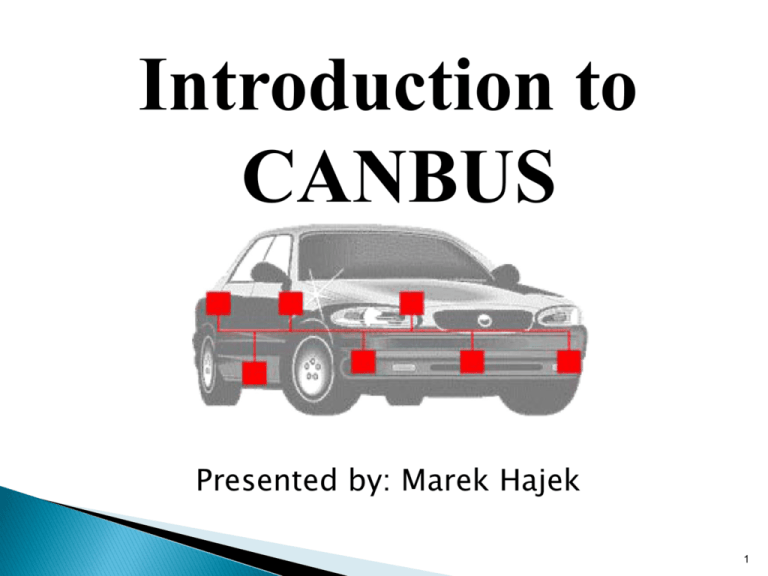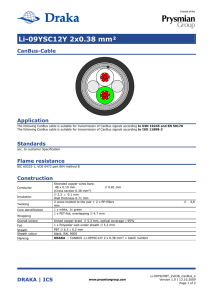
Introduction to
CANBUS
Presented by: Marek Hajek
1
1.
CANBUS Introduction
2.
CANBUS Characteristics
3.
4.
5.
What is CANBUS?
Who uses CANBUS?
CANBUS history
CANBUS timeline
OSI Model
Physical Layer
Transmission Characteristics
Message Oriented Communication
Message Format
Bus Arbitration
2
CANBUS or CAN bus – Controller Area Network bus
An automotive serial bus system developed to satisfy
the following requirements:
Network multiple microcontrollers with 1 pair of wires.
Allow microcontrollers communicate with each other.
High speed, real-time communication.
Provide noise immunity in an electrically noisy environment.
Low cost
3
Designed specifically for automotive applications
Today - industrial automation / medical equipment
CANBUS Market Distribution
100%
90%
80%
70%
60%
50%
40%
30%
20%
10%
0%
Automotive
Medical / Industrial
Markets
4
First idea - The idea of CAN was first conceived by
engineers at Robert Bosch Gmbh in Germany in the
early 1980s.
Early focus - develop a communication system
between a number of ECUs (electronic control
units).
New standard - none of the communication
protocols at that time met the specific
requirements for speed and reliability so the
engineers developed their own standard.
5
1983 : First CANBUS project at Bosch
1986 : CAN protocol introduced
1987 : First CAN controller chips sold
1991 : CAN 2.0A specification published
1992 : Mercedes-Benz used CAN network
1993 : ISO 11898 standard
1995 : ISO 11898 amendment
Present : The majority of vehicles use CAN bus.
6
CAN is a closed network
◦ – no need for security, sessions or logins.
◦ - no user interface requirements.
Physical and Data Link layers in silicon.
7
Physical medium – two wires terminated at both ends by resistors.
Differential signal - better noise immunity.
Benefits:
Reduced weight, Reduced cost
Fewer wires = Increased reliability
Conventional multi-wire looms
CAN bus network
vs.
http://canbuskit.com/what.php
8
Up to 1 Mbit/sec.
Common baud rates: 1 MHz, 500 KHz and 125 KHz
All nodes – same baud rate
Max length:120’ to 15000’ (rate dependent)
© esd electronics, Inc. • 525 Bernardston Road • Greenfield, MA 01301
9
Each node – receiver & transmitter
A sender of information transmits to all devices on the bus
All nodes read message, then decide if it is relevant to them
All nodes verify reception was error-free
All nodes acknowledge reception
CAN bus
© 2005 Microchip Technology Incorporated. All Rights Reserved.
10
Each message has an ID, Data and overhead.
Data –8 bytes max
Overhead – start, end, CRC, ACK
11
12
Arbitration – needed when multiple nodes try to transmit at the
same time
Only one transmitter is allowed to transmit at a time.
A node waits for bus to become idle
Nodes with more important messages continue transmitting
CAN bus
© 2005 Microchip Technology Incorporated. All Rights Reserved.
13
Message importance is encoded in message ID.
Lower value = More important
As a node transmits each bit, it verifies that it sees
the same bit value on the bus that it transmitted.
A “0” on the bus wins over a “1” on the bus.
Losing node stops transmitting, winner continues.
14
CAN bus – Controller Area Network bus
Primarily used for building ECU networks in
automotive applications.
Two wires
OSI - Physical and Data link layers
Differential signal - noise immunity
1Mbit/s, 120’
Messages contain up to 8 bytes of data
15
Marek Hajek
16
A “0” (low voltage) on the bus by 1 node
wins over a “1” (high voltage) on the bus.
17
18








